 About Authors:
About Authors:
C.P.Meher*, S.P.Sethy, M.Madhavi
*Asst. Professor
Maheshwara Institute of Pharmacy,
Chitkul, Patancheru, Medak, A.P
*chaitanyameher84@gmail.com
ABSTRACT:
Medicinal chemistry and pharmaceutical chemistry are disciplines at the intersection of chemistry, especially synthetic organic chemistry, and pharmacology and various other biological specialties, where they are involved with design, chemical synthesis and development for market of pharmaceutical agents, or bio-active molecules (drugs).Very important part of above is the heterocyclic-chemistry. Now a days so many investigation are carried out for developing new chemical entities having suitability for human life. A lot of research work is going on presently for development of new heterocyclic derivatives.The present review article is concern with the three, five-membered heterocyclic compound pyrrole, furan & thiophene derivatives that show diverse pharmacological activities.
[adsense:336x280:8701650588]
Reference Id: PHARMATUTOR-ART-1528
INTRODUCTION:
Pharmaceutical chemistry is focused on quality aspects of medicines and aims to assure fitness for purpose of medicinal products. At the biological interface, medicinal chemistry combines to form a set of highly interdisciplinary sciences, setting its organic, physical, and computational emphases alongside biological areas such as biochemistry, molecular biology, pharmacognosy and pharmacology, toxicology and veterinary and human medicine; these, with project management, statistics, and pharmaceutical business practices, systematically oversee altering identified chemical agents such that after pharmaceutical formulation, they are safe and efficacious, and therefore suitable for use in treatment of disease. The three heterocyclic compound have a wide range of biological properties that provide an increasing number of therapeutic applications. Some properties are common to all the three(pyrrole,furan,thiophene) whereas others are characteristic only of certain compounds. Considerable insight may be gained into the mechanism of action of the pyrrole,furan,thiophene by seeking correlations between their chemical and biological properties.
[adsense:468x15:2204050025]
A comparative study of the three heterocyclic nucleus are briefly describe in table-1 as below
Table-1
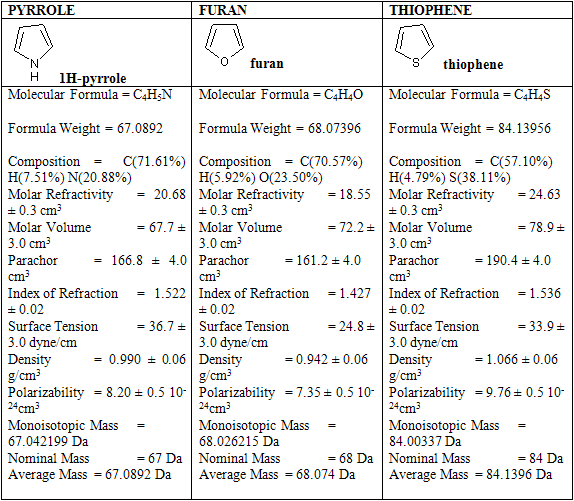
Numerous biological activity of the three heterocyclic derivatives(pyrrole,furan,thiophene) are given in table-2,table-3 & table-4 respectively.
PYRROLE:
Pyrrole is a heterocyclic aromatic organic compound, a five-membered ring with the formula C4H4NH. It is a colourless volatile liquid that darkens readily upon exposure to air. Substituted derivatives are also called pyrroles, e.g., N-methylpyrrole, C4H4NCH3. Porphobilinogen, a trisubstituted pyrrole, is the biosynthetic precursor to many natural products such as heme.Pyrroles are components of more complex macrocycles, including the porphyrins of heme, the chlorins, bacteriochlorins, chlorophyll, porphyrinogens. Given below is a brief account of various alterations conducted on pyrrole ring containing few important marketed drugs, drugs under clinical trial and their associated biological activities in table-2.
Table-2
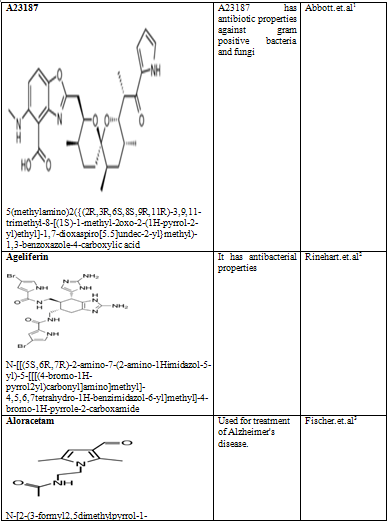
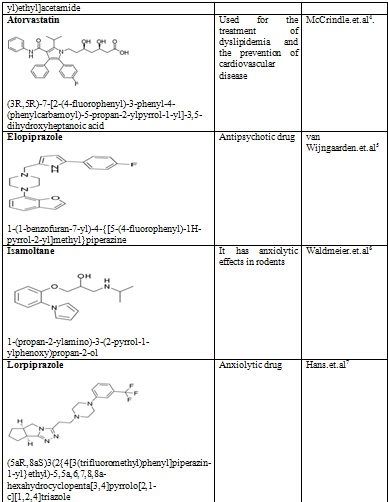
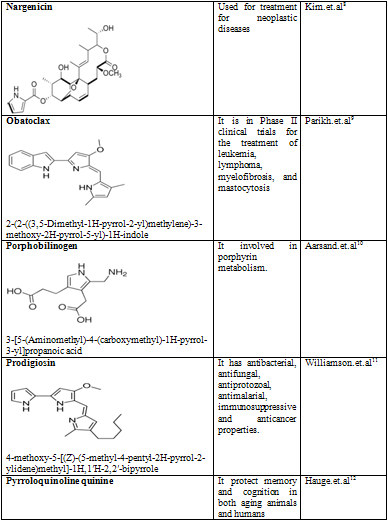
NOW YOU CAN ALSO PUBLISH YOUR ARTICLE ONLINE.
SUBMIT YOUR ARTICLE/PROJECT AT articles@pharmatutor.org
Subscribe to Pharmatutor Alerts by Email
FIND OUT MORE ARTICLES AT OUR DATABASE

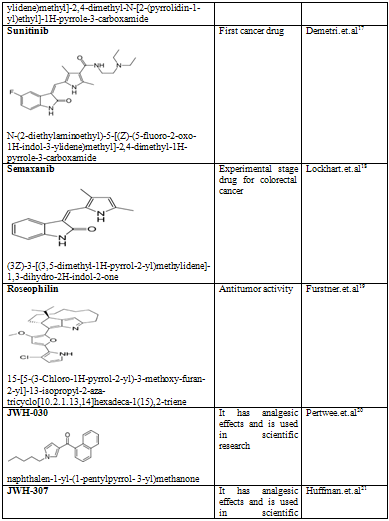
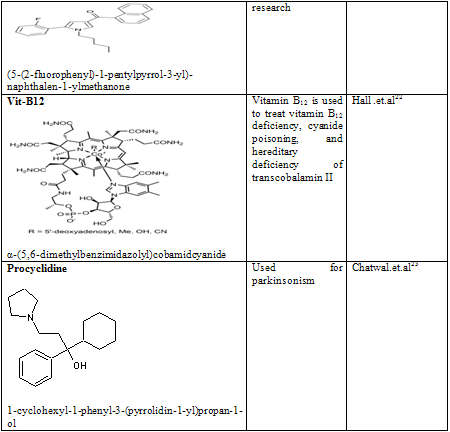
FURAN:
Furan is a heterocyclic organic compound, consisting of a five-membered aromatic ring with four carbon atoms and one oxygen. The class of compounds containing such rings are also referred to as furans. Furan is a colorless, flammable, highly volatile liquid with a boiling point close to room temperature. It is soluble in common organic solvents, including alcohol, ether and acetone, but is insoluble in water. It is toxic and may be carcinogenic. Furan is used as a starting point to other specialty chemicals.Various biological activities that are associated with the furan are derivatives are given in table-3.
Table-3
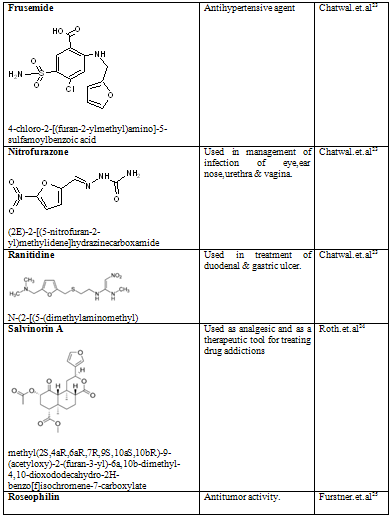
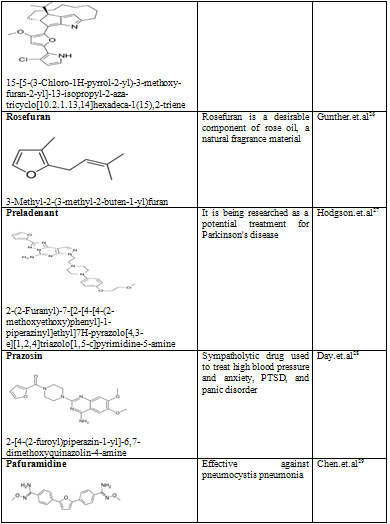
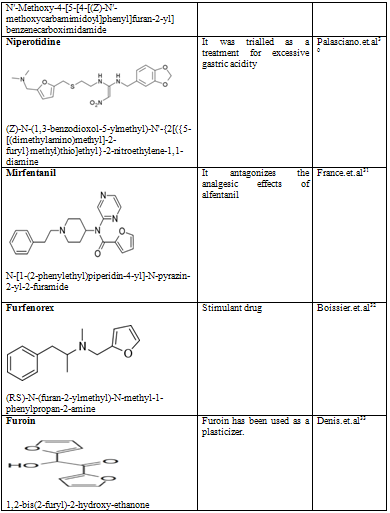
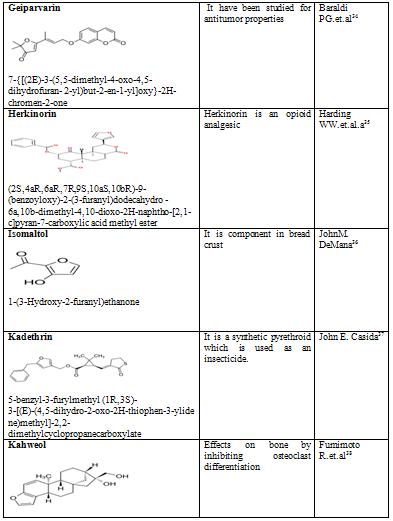
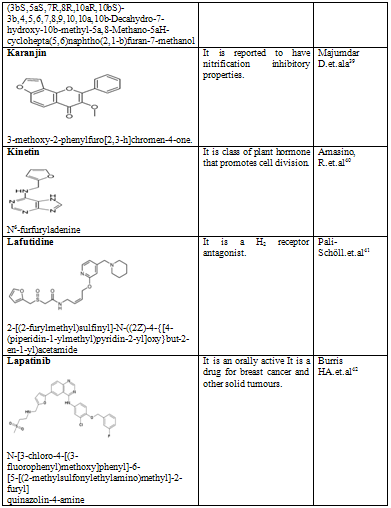
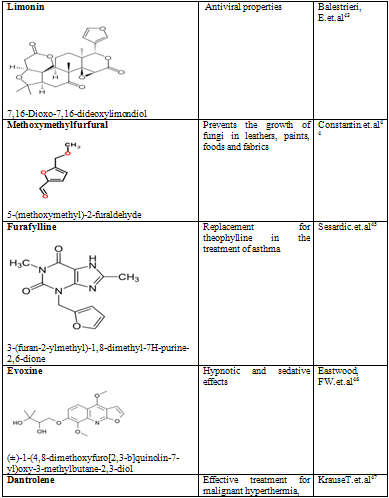
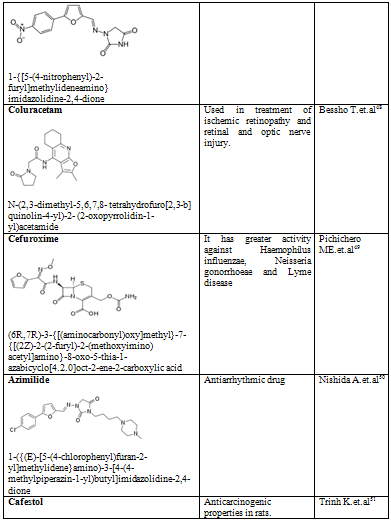

THIOPHENE:
Thiophene, also commonly called thiofuran, is a heterocycliccompound with the formula C4H4S. Consisting of a flat five-membered ring, it is aromaticas indicated by its extensive substitution reactions. Related to thiophene are benzothiophene and dibenzothiophene, containing the thiophene ring fused with one and two benzene rings, respectively. Compounds analogous to thiophene include furan(C4H4O) and pyrrole(C4H4NH).A large number of biological activity that are associated with the pyrrole nucleus containing drugs are given in table-4
NOW YOU CAN ALSO PUBLISH YOUR ARTICLE ONLINE.
SUBMIT YOUR ARTICLE/PROJECT AT articles@pharmatutor.org
Subscribe to Pharmatutor Alerts by Email
FIND OUT MORE ARTICLES AT OUR DATABASE
Table-4
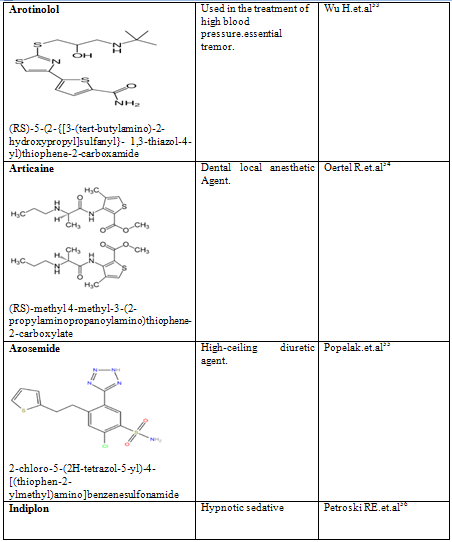
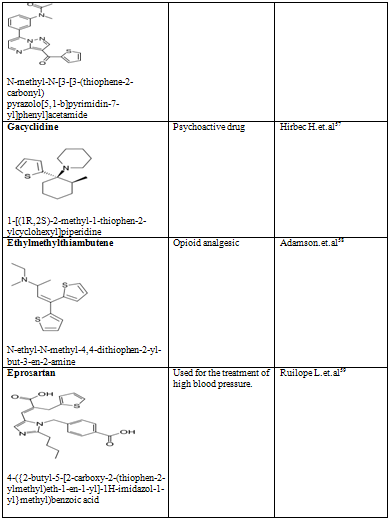
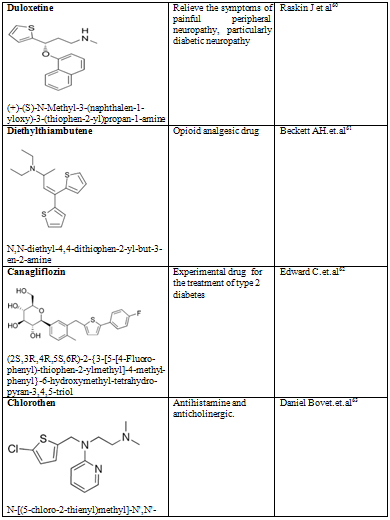

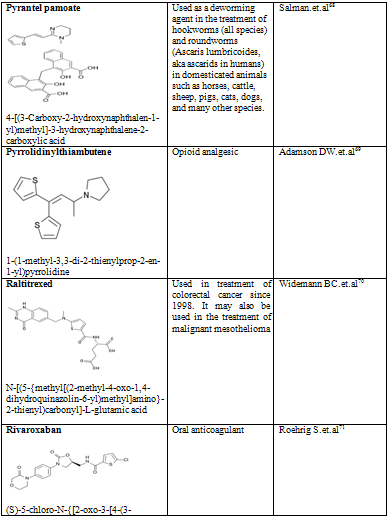

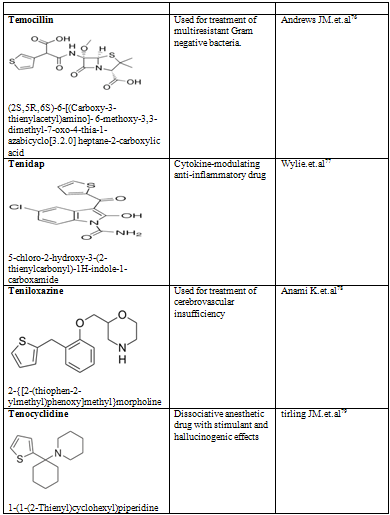
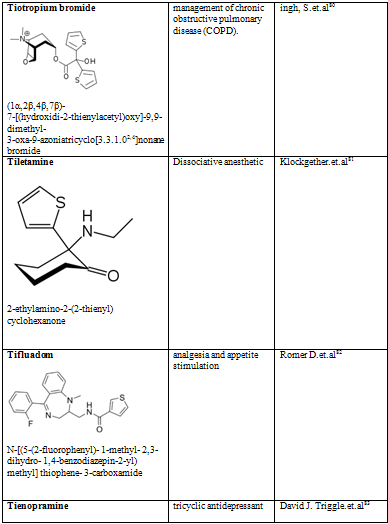
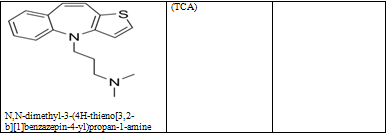
NOW YOU CAN ALSO PUBLISH YOUR ARTICLE ONLINE.
SUBMIT YOUR ARTICLE/PROJECT AT articles@pharmatutor.org
Subscribe to Pharmatutor Alerts by Email
FIND OUT MORE ARTICLES AT OUR DATABASE
CONCLUSION:
Hetero cyclic compound containing pyrrole, furan, thiophene nucleus plays most important role in the the field of clinical therapeutics.It shows wide range of activities for medication purpose. Vast number of pyrrole, furan & thiophene containing compounds have been synthesized and evaluated for their biological activity.The various substituted pyrrole, furan, thiophene are having significant antihypertensive activity., Significant antineoplastic and Non-steroidal anti-inflammatory drug, some modified pyrrole, furan, thiophene are found to to be effective as tricyclic antidepressant, Dissociative anesthetic,antibacterial properties, Antipsychotic. whereas some of the derivatives of pyrrole, furan, thiophene are found to be effective as analgesic, antipsychotic, Antiarrhythmic, sedative hypnotics. Recently it was proven that, some of the important marketed pyrrole, furan, thiophene nucleous containing drug having different biological or pharmacological activity were discussed in table above. The pyrrole, furan, thiophene based pharmaceutical are rapidly becoming very important class of therapeutic agents and are likely to replace many existing organic based pharmaceuticals in the very near future. The pyrrole, furan, thiophene based pharmaceuticals will be produced on a large scale by modern drug Discovery Company by different research development processes and will be come available commercially for therapeutic use. With the key benefits including favorable time to market and high rate of success in clinical trial compared with traditional pharmaceuticals due to diverse biological action with less toxicity, so in future therapeutic pyrrole, furan, thiophene drug will play vital role in the treatment of different diseases. The biological profiles of this new generation of pyrrole, furan, thiophene represent much progress with regard to the older compounds.
REFERENCES:
1. Abbott, Bernard; D S Fukuda, D E Dorman, J L Occolowitz, M Debono, and L Farhner (1979). "Microbial transformation of A23187, a divalent cation ionophore antibiotic". Antimicrobial Agents and Chemotherapy 16 (6): 808–812.
2. Rinehart, Kenneth L, et al. (1990). "Bioactive Compounds from Aquatic and Terrestrial Sources". Journal of Natural Products 53 (4): 771–792.
3. Fischer F, Matthisson M, Herrling P. List of Drugs in Development for Neurodegenerative Diseases. Neurodegenerative Diseases 2004;1:50–70.
4. McCrindle BW, Ose L, Marais AD (July 2003). "Efficacy and safety of atorvastatin in children and adolescents with familial hypercholesterolemia or severe hyperlipidemia: a multicenter, randomized, placebo-controlled trial". J. Pediatr. 143 (1): 74–80.
5. van Wijngaarden I, Kruse CG, van Hes R, van der Heyden JA, Tulp MT (November 1987). "2-Phenylpyrroles as conformationally restricted benzamide analogues. A new class of potential antipsychotics. 1". Journal of Medicinal Chemistry 30 (11): 2099–104.
6. Waldmeier PC, Williams M, Baumann PA, Bischoff S, Sills MA, Neale RF. (1988). "Interactions of isamoltane (CGP 361A), an anxiolytic phenoxypropanolamine derivative, with 5-HT1 receptor subtypes in the rat brain.". Naunyn Schmiedebergs Arch Pharmacol. 337 (6): 609–620.
7. Hans -Georg Scharnow; Negwer, Martin (2001). Organic-Chemical Drugs and Their Synonyms, 8th Edition (v. 1-6). Weinheim: Wiley-VCH
8. Kim, SH; Yoo, JC; Kim, TS (2009). "Nargenicin enhances, dihydroxyvitamin D-3 and all-trans retinoic acid-induced leukemia cell differentiation via PKC beta I/MAPK pathways". Biochemical Pharmacology 77 (11): 1694–1701
9. Parikh, Sameer A.; Kantarjian, Hagop; Schimmer, Aaron; Walsh, William; Asatiani, Ekatherine; El-Shami, Khaled; Winton, Elliott; Verstovsek, Srdan (2010). "Phase II study of obatoclax mesylate (GX15-070), a small-molecule BCL-2 family antagonist, for patients with myelofibrosis". Clinical Lymphoma, Myeloma & Leukemia 10 (4): 285–289.
10. Aarsand, AK; Petersen PH, Sandberg S (April 2006). "Estimation and application of biological variation of urinary delta-aminolevulinic acid and porphobilinogen in healthy individuals and in patients with acute intermittent porphyria". Clinical Chemistry 52 (4): 650–656.
11. Williamson NR, Fineran PC, Gristwood T, Leeper FJ, Salmond GP (2006). "The biosynthesis and regulation of bacterial prodiginines". Nature Reviews Microbiology 4 (12): 887–899.
12. Hauge JG (1964). "Glucose dehydrogenase of bacterium anitratum: an enzyme with a novel prosthetic group". J Biol Chem 239: 3630–9.
13. Lewis JR (1981). "Zomepirac sodium. A new nonaddicting analgesic". JAMA 246 (4): 377–9.
14. Contri AM. Chromatographic separation of diastereoisomers of aminoalcohol salts and their densitometric determination. (Italian). Il Farmaco. 1981 Apr;36(4):215-22.
15. Cordrey L J (1976). "Tolmetin sodium, a new anti-arthritis drug: double-blind and long-term studies". Journal of the American Geriatrics Society 24 (10): 440–446.
16. London CA, Malpas PB, Wood-Follis SL, et al. (June 2009). "Multi-center, Placebo-controlled, Double-blind, Randomized Study of Oral Toceranib Phosphate (SU11654), a Receptor Tyrosine Kinase Inhibitor, for the Treatment of Dogs with Recurrent (Either Local or Distant) Mast Cell Tumor Following Surgical Excision.". Clin Cancer Res 15 (11): 3856–65.
17. Demetri GD et al. (2006). "Efficacy and safety of sunitinib in patients with advanced gastrointestinal stromal tumour after failure of imatinib: a randomised controlled trial". Lancet 368 (9544): 1329–1338
18. Lockhart A, Cropp G, Berlin J, Donnelly E, Schumaker R, Schaaf L, Hande K, Fleischer A, Hannah A, Rothenberg M (2006). "Phase I/pilot study of SU5416 (semaxinib) in combination with irinotecan/bolus 5-FU/LV (IFL) in patients with metastatic colorectal cancer". Am J Clin Oncol 29 (2): 109–15
19. Furstner, A. (2003). Angew. Chem., Int. Ed. 42 (3582-3603).
20. Pertwee RG, Griffin, G, Lainton JAH, Huffman JW. European Journal of Pharmacology. 1995; 284:241
21. Huffman JW, Padgett LW, Isherwood ML, Wiley JL, Martin BR. 1-Alkyl-2-aryl-4-(1-naphthoyl)pyrroles: New high affinity ligands for the cannabinoid CB1 and CB2 receptors. Bioorganic & Medicinal Chemistry Letters 2006; 16:5432-5435.
22. Hall AH, Rumack BH (1987). "Hydroxycobalamin/sodium thiosulfate as a cyanide antidote". The Journal of Emergency Medicine 5 (2): 115–21
23. pharmaceutical organic chemistry-II,chatwal G.R,P-1.17,1.13,
24. Roth BL, Baner K, Westkaemper R, Siebert D, Rice KC, Steinberg S, Ernsberger P, Rothman RB (2002). "Salvinorin A: a potent naturally occurring nonnitrogenous κ opioid selective agonist". Proceedings of the National Academy of Sciences U.S.A. 99 (18): 11934–9.
25. Furstner, A. (2003). Angew. Chem., Int. Ed. 42 (3582-3603).
26. Gunther Ohloff (1978). "Importance of minor components in flavors and fragrances". Perfumer & Flavorist 3 (1): 11–22.
27. Hodgson RA, Bertorelli R, Varty GB, Lachowicz JE, Forlani A, Fredduzzi S, Cohen-Williams ME, Higgins GA, Impagnatiello F, Nicolussi E, Parra LE, Foster C, Zhai Y, Neustadt BR, Stamford AW, Parker EM, Reggiani A, Hunter JC (March 2009). "Characterization of the Potent and Highly Selective A2A Receptor Antagonists Preladenant and SCH 412348 in Rodent Models of Movement Disorders and Depression". The Journal of Pharmacology and Experimental Therapeutics 330 (1): 294–303.
28. Day, H. E.; Campeau, S.; Watson Jr, S. J.; Akil, H. (1997). "Distribution of alpha 1a-, alpha 1b- and alpha 1d-adrenergic receptor mRNA in the rat brain and spinal cord". Journal of chemical neuroanatomy 13 (2): 115–139.
29. Chen, D; Marsh, R; Aberg, JA (2007). "Pafuramidine for Pneumocystis jiroveci pneumonia in HIV-infected individuals". Expert review of anti-infective therapy 5 (6): 921–8
30. Palasciano G, Maggi V, Portincasa P. The effect of the H2-antagonist niperotidine on intragastric acidity in healthy subjects undergoing 24-hour pH-monitoring. Italian Journal of Gastroenterology. 1990 Oct;22(5):291-4
31. France CP, Winger G, Medzihradsky F, Seggel MR, Rice KC, Woods JH. "Mirfentanil: pharmacological profile of a novel fentanyl derivative with opioid and nonopioid effects." Journal of Pharmacology and Experimental Therapeutics. 1991 Aug;258(2):502-10
32. Boissier, JR; Dumont, C; Ratouis, R; Moisy, D (1967). "Pharmacologic study of an anorexigenic agent: furfenorex". Archives internationales de pharmacodynamie et de therapie 167 (1): 150–62.
33. Denis Lorient (1999), New ingredients in food processing: biochemistry and agriculture. Woodhead Publishing. ISBN 1-85573-443-5. 366 pages
34. Baraldi PG, Guarneri M, Manfredini S, Simoni D, Balzarini J, De Clercq E (February 1989). "Synthesis and cytostatic activity of geiparvarin analogues". J Med Chem 32 (2): 284–288.
35. Harding WW, Tidgewell K, Byrd N, Cobb H, Dersch CM, Butelman ER, Rothman RB, Prisinzano TE. "Neoclerodane diterpenes as a novel scaffold for mu opioid receptor ligands." Journal of Medicinal Chemistry. 2005 Jul 28;48(15):4765-7.
36. Principles of Food Chemistry (1999), John M. DeMan, pg 286
37. John E. Casida: Pyrethrum Flowers and Pyrethroid Insecticides
38. Fumimoto R, Sakai E, Yamaguchi Y, Sakamoto H, Fukuma Y, Nishishita K, Okamoto K, Tsukuba T (Mar 2012). "The Coffee Diterpene Kahweol Prevents Osteoclastogenesis via Impairment of NFATc1 Expression and Blocking of Erk Phosphorylation.". J Pharmacol Sci 23. doi:10.1254/jphs.11212FP
39. Potential use of karanjin (3-methoxy furano-2,3,7,8-flavone) as a nitrification inhibitor in different soil types. Majumdar D.; Pandya B.; Arora A.; Dhara S., Archives of Agronomy and Soil Science, Volume 50, Numbers 4-5, Numbers 4-5/August-October 2004 , pp. 455-465.
40. Amasino, R. (2005). "1955: Kinetin Arrives. The 50th Anniversary of a New Plant Hormone". Plant Physiology 138 (3): 1177–1184.
41. Pali-Schöll I, Jensen-Jarolim E (April 2011). "Anti-acid medication as a risk factor for food allergy". Allergy 66 (4): 469–77.
42. Burris HA (2004) Dual kinase inhibition in the treatment of breast cancer: initial experience with the EGFR/ErbB-2 inhibitor lapatinib". Oncologist 9 Suppl 3: 10–5.
43. Balestrieri, E.; Pizzimenti, F.; Ferlazzo, A.; Giofrè, S. V.; Iannazzo, D.; Piperno, A.; Romeo, R.; Chiacchio, M. A. et al. (2011). "Antiviral activity of seed extract from Citrus bergamia towards human retroviruses". Bioorganic & Medicinal Chemistry 19 (6): 2084–2089
44. Constantin, J.M., Humphreys, T.W. Lange, H.B. Shew, D. and Wagner, J.R. (1963) US. Patent 3,080,279, Mar. 5, 1963.
45. Sesardic, D.; Boobis, A. R.; Murray, B. P.; Murray, S.; Segura, J.; De La Torre, R.; Davies, D. S. (1990). "Furafylline is a potent and selective inhibitor of cytochrome P450IA2 in man". British Journal of Clinical Pharmacology 29 (6): 651–663.
46. Eastwood, FW; Hughes, GK; Ritchie, E. (1954). "Alkaloids of the Australian Rutaceae: Evodia xanthoxyloides F.Muell. IV. The structures of Evoxine and Evoxoidine". Australian Journal of Chemistry 7 (1): 87–98.
47. Krause T, Gerbershagen MU, Fiege M, Weisshorn R, Wappler F (2004). "Dantrolene – a review of its pharmacology, therapeutic use and new developments". Anaesthesia 59 (4): 364–73
48. Bessho, T; Takashina, K; Tabata, R; Ohshima, C; Chaki, H; Yamabe, H; Egawa, M; Tobe, A et al. (1996). "Effect of the novel high affinity choline uptake enhancer 2-(2-oxopyrrolidin-1-yl)-N-(2,3-dimethyl-5,6,7,8-tetrahydrofuro2,3-b quinolin-4-yl)acetoamide on deficits of water maze learning in rats". Arzneimittel-Forschung 46 (4): 369–73.
49. Pichichero ME (2006). "Cephalosporins can be prescribed safely for penicillin-allergic patients" (PDF). The Journal of family practice 55 (2): 106–12
50. Nishida A.,Reien Y.,Ogura T.,Uemura H.,Tamagawa M.,Yabana H.,Nakaya H.(2007).Effects of azimilide on the muscarinic acetylcholine receptor-operated K+current and experimental atrial fibrillation in guinea-pig hearts.Journal of Pharmacological Sciences 105,229-239
51. Trinh K, Andrews L, Krause J, Hanak T, Lee D, Gelb M, Pallanck L (April 2010). "Decaffeinated coffee and nicotine-free tobacco provide neuroprotection in Drosophila models of Parkinson's disease through an NRF2-dependent mechanism". J. Neurosci. 30 (16): 5525–32.
52. Donaldson SC, Straley BA, Hegde NV, Sawant AA, DebRoy C, Jayarao BM (2006). "Molecular epidemiology of ceftiofur-resistant Escherichia coli isolates from dairy calves". Appl. Environ. Microbiol. 72 (6): 3940–8.
53. Wu H, Zhang Y, Huang J, et al. (September 2001). "Clinical trial of arotinolol in the treatment of hypertension: dippers vs. non-dippers"Hypertens. Res. 24 (5): 605–10
54. Oertel R, Ebert U, Rahn R, Kirch W. Clinical pharmacokinetics of articaine. Clin Pharmacokinet. 1997 Dec;33(6):421
55. Popelak, A.; Lerch, A.; Stach, K.; Roesch, E.; Hardebeck, K.; German Offen., 1970, 815922; Chem. Abstr. 1970, 73, 45519.
56. Petroski RE, Pomeroy JE, Das R et al. (April 2006). "Indiplon is a high-affinity positive allosteric modulator with selectivity for alpha1 subunit-containing GABAA receptors" (PDF). J. Pharmacol. Exp. Ther. 317 (1): 369–77
57. Hirbec H, Gaviria M, Vignon J. Gacyclidine: a new neuroprotective agent acting at the N-methyl-D-aspartate receptor. CNS Drug Reviews. 2001 Summer;7(2):172-98.
58. Adamson, DW; Green, AF (1950). "A new series of analgesics". Nature 165 (4186): 122–122.
59. Ruilope L, Jäger B, Prichard B (2001). "Eprosartan versus enalapril in elderly patients with hypertension: a double-blind, randomized trial". Blood Press. 10 (4): 223–9.
60. Raskin J et al. (June 2007). "Efficacy of duloxetine on cognition, depression, and pain in elderly patients with major depressive disorder: an 8-week, double-blind, placebo-controlled trial". Am J Psychiatry 164 (6):900-9.
61. BECKETT AH, CASY AF, HARPER NJ, PHILLIPS PM. Analgesics and their antagonists: some steric and chemical considerations. II. The influence of the basic group on physico-chemical properties and the activity of methadone and thiambutene-type compounds. Journal of Pharmacy and Pharmacology. 1956 Nov;8(11):860-73.
62. Edward C. Chao (2011). "Canagliflozin". Drugs of the Future 36 (5): 351–357.
63. Daniel Bovet (April 1950). "Introduction to antihistamine agents and antergan derivatives". Annals of the New York Academy of Sciences 50: 1089–1126.
64. Henderson GL. Designer Drugs: Past History and Future Prospects. Journal of Forensic Sciences 1988; 33(2):569-575
65. Van Gelder, J.; Roevens, L. F. C.; Belgians, L. H.; Rayemaekers, A. H. M; 1972, U.S. Patent 3,657,267
66. Adamson DW, Green AF. A new series of analgesics. Nature. 1950 Jan 21;165(4186):122.
67. Aceves, J., Erlij, D., and Martinez-Maranon, R. (1970). The mechanism of the paralysing action of tetramisole on Ascaris somatic muscle. Br. J. Pharmacol. 38, 602–607.
68. Salman, A.Bedii (1997). "Management of intestinal obstruction caused by ascariasis". Journal of Pediatric Surgery 32 (4): 585–587.
69. Adamson DW, Green AF. A new series of analgesics. Nature. 1950 Jan 21;165(4186):122.
70. Widemann BC, Balis FM, Godwin KS, McCully C, Adamson PC (1999). "The plasma pharmacokinetics and cerebrospinal fluid penetration of the thymidylate synthase inhibitor raltitrexed (Tomudex) in a nonhuman primate model". Cancer Chemother. Pharmacol. 44 (6): 439–43.
71. Roehrig S, Straub A, Pohlmann J, et al. (September 2005). "Discovery of the novel antithrombotic agent 5-chloro-N-({(5S)-2-oxo-3- [4-(3-oxomorpholin-4-yl)phenyl]-1,3-oxazolidin-5-yl}methyl)thiophene- 2-carboxamide (BAY 59-7939): an oral, direct factor Xa inhibitor". Journal of Medicinal Chemistry 48 (19): 5900–8.
72. Chen JJ, Swope DM, Dashtipour K, Lyons KE (December 2009). "Transdermal rotigotine: a clinically innovative dopamine-receptor agonist for the management of Parkinson's disease". Pharmacotherapy 29 (12): 1452–67.
73. Barst RJ, Langleben D, Frost A et al. (2004). "Sitaxsentan therapy for pulmonary arterial hypertension". American Journal of Respiratory Critical Care Medicine 169 (4): 441–447
74. Niemegeers CJ, Schellekens KH, Van Bever WF, Janssen PA (1976). "Sufentanil, a very potent and extremely safe intravenous morphine-like compound in mice, rats and dogs". Arzneimittel-Forschung 26 (8): 1551–6
75. Nies A S (1988). "Renal effects of nonsteroidal anti-inflammatory drugs". Agents and actions 24: 95-106.
76. Andrews JM, Jevons G, Walker R, Ashby J, Fraise AP (July 2007). "Temocillin susceptibility by BSAC methodology". J. Antimicrob. Chemother. 60 (1): 185–7
77. Wylie, G.; Appelboom, T.; Bolten, W.; Breedveld, F. C.; Feely, J.; Leeming, M. R.; Le Loët, X.; Manthorpe, R. et al. (1995). "A comparative study of tenidap, a cytokine-modulating anti-rheumatic drug, and diclofenac in rheumatoid arthritis: A 24-week analysis of a 1-year clinical trial". British journal of rheumatology 34 (6): 554–563.
78. Anami K, Yamamoto Y, Setoguchi M (February 1985). "[Pharmacological studies on sufoxazine (Y-8894). (I) Effects on experimental amnesia in mice]" (in Japanese). Nihon Yakurigaku Zasshi. Folia Pharmacologica Japonica 85 (2): 71–7.
79. tirling JM, Cross AJ, Green AR. The binding of [3H]thienyl cyclohexylpiperidine ([3H]TCP) to the NMDA-phencyclidine receptor complex. Neuropharmacology. 1989 Jan;28(1):1-7.
80. ingh, S; Loke, YK, Enright, PL, Furberg, CD (2011 Jun 14). "Mortality associated with tiotropium mist inhaler in patients with chronic obstructive pulmonary disease: systematic review and meta-analysis of randomised controlled trials.". BMJ (Clinical research ed.) 342
81. Klockgether, Thomas; Turski, Lechoslaw, Schwarz, Michael, Sontag, Karl-Heinz, Lehmann, John (1 October 1988). "Paradoxical convulsant action of a novel non-competitiveN-methyl-d-aspartate (NMDA) antagonist, tiletamine". Brain Research 461 (2): 343–348
82. Romer D, Buscher HH, Hill RC, Maurer R, Petcher TJ, Zeugner H, Benson W, Finner E, Milkowski W, Thies PW. Unexpected opioid activity in a known class of drug. Life Sciences. 1982 Sep 20-27;31(12-13):1217-20.
83. David J. Triggle (1996). Dictionary of Pharmacological Agents. Boca Raton: Chapman & Hall/CRC
NOW YOU CAN ALSO PUBLISH YOUR ARTICLE ONLINE.
SUBMIT YOUR ARTICLE/PROJECT AT articles@pharmatutor.org
Subscribe to Pharmatutor Alerts by Email
FIND OUT MORE ARTICLES AT OUR DATABASE










